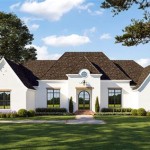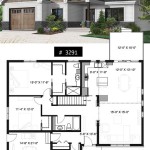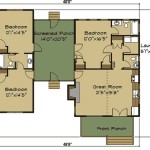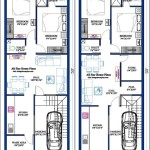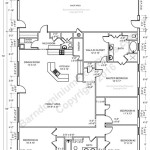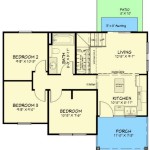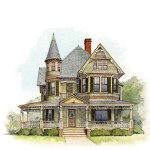Exploring the Charm and Functionality of Tudor Style Home Floor Plans
Tudor style homes, evocative of 16th-century English architecture, offer a unique blend of historical charm and modern living. Characterized by steeply pitched roofs, decorative half-timbering, and prominent gables, these homes possess a distinct visual appeal. Understanding the intricacies of Tudor style home floor plans is crucial for both appreciating their design and adapting them to contemporary needs. This article explores the key features, common layouts, and considerations for modern adaptations of Tudor style home floor plans.
Key Features of Tudor Style Home Floor Plans
Tudor floor plans are often defined by several recurring features that contribute to their distinctive aesthetic and functionality. These elements reflect the architectural trends and lifestyle considerations prevalent during the Tudor era. Understanding these features provides a foundation for analyzing and appreciating the overall design of a Tudor-style home.
One of the most notable features is the emphasis on clearly defined rooms. Open-concept living, a popular trend in modern home design, is generally absent in traditional Tudor layouts. Instead, individual rooms are designated for specific purposes, such as a formal living room, a separate dining room, and a distinct kitchen space. This compartmentalization reflects the historical emphasis on formality and the separation of domestic activities.
Fireplaces are another crucial element in Tudor floor plans. Serving as a central source of heat and a focal point for gathering, fireplaces are often prominently featured in the living room or great room. Their design frequently incorporates elaborate mantels and decorative details, further enhancing the architectural character of the space. The presence of multiple fireplaces throughout the home is not uncommon, reflecting the need for localized heating in the absence of modern central heating systems.
The use of small, often leaded-glass windows is also a defining characteristic. While these windows contribute to the distinctive aesthetic of Tudor homes, they can also impact the amount of natural light entering the interior. This has implications for the interior layout and the placement of living spaces, often requiring careful consideration of lighting strategies to compensate for the smaller window apertures.
Finally, the presence of a grand entryway or foyer is a common feature. This space serves as a transitional area, providing a formal introduction to the home's interior. It often includes a staircase leading to the upper floors and serves as a central point for connecting different areas of the house. The size and design of the entryway contribute to the overall impression of formality and grandeur associated with Tudor architecture.
Common Layouts and Room Configurations
While variations exist, certain layouts and room configurations are commonly found in Tudor style home floor plans. These layouts reflect the typical needs and priorities of households during the Tudor period, as well as the constraints imposed by the architectural style itself. Understanding these common layouts provides a valuable framework for analyzing and adapting existing Tudor homes or designing new ones in the Tudor style.
A two-story layout is prevalent, with the main living areas typically located on the ground floor and the bedrooms situated on the upper floor. This separation of living and sleeping areas is a common characteristic of many traditional home designs. The placement of the kitchen is often at the rear of the house, reflecting its historical role as a service area. In some cases, the kitchen may be connected to a breakfast nook or a small family room, providing a more informal space for everyday dining.
The living room is generally positioned at the front of the house, often featuring a large fireplace and multiple windows. This space is intended for formal entertaining and social gatherings. The dining room is typically located adjacent to the living room, allowing for easy access during meals. The placement of these rooms reflects the importance of formal social interactions in Tudor society.
The upper floor typically houses the bedrooms, with the master bedroom often being the largest and most elaborately decorated. Additional bedrooms are provided for family members or guests. Bathrooms are usually located near the bedrooms, reflecting the modern need for convenient access to sanitary facilities. The size and number of bedrooms vary depending on the overall size and design of the house.
In some cases, Tudor style homes may include a separate wing or extension housing additional living spaces, such as a library, a study, or a recreational room. These additions provide greater flexibility and functionality, allowing homeowners to tailor the layout to their specific needs and preferences. The presence of these additional spaces further enhances the overall value and desirability of the home.
Adapting Tudor Floor Plans for Modern Living
While Tudor homes possess undeniable charm and architectural significance, their traditional floor plans may not always be ideally suited to the needs of modern homeowners. Adapting these floor plans for contemporary living requires careful consideration of various factors, including the homeowner's lifestyle, the existing architectural features, and the desired level of modernization. Strategic modifications can enhance the functionality and comfort of a Tudor home without sacrificing its inherent character.
One of the most common adaptations is the integration of open-concept living spaces. This can be achieved by removing walls between the kitchen, dining room, and living room, creating a more fluid and interconnected environment. However, it is important to proceed with caution when implementing this type of modification, as it can potentially compromise the architectural integrity of the house. Careful planning and design are essential to ensure that the open-concept space complements the overall style of the home.
Another important consideration is the optimization of natural light. The small windows characteristic of Tudor homes can often result in dim interiors. Expanding existing windows or adding new ones can significantly improve the amount of natural light entering the house. Skylights can also be used to provide additional illumination in areas that are difficult to reach with traditional windows. The strategic placement of lighting fixtures can further enhance the brightness and ambiance of the interior spaces.
Modernizing the kitchen and bathrooms is another common adaptation. Updating appliances, installing new fixtures, and improving the overall layout can significantly enhance the functionality and comfort of these spaces. However, it is important to select materials and finishes that are consistent with the Tudor style. Granite countertops, stainless steel appliances, and modern cabinetry can often clash with the traditional aesthetic of a Tudor home. Opting for more classic materials, such as wood countertops, vintage-style appliances, and traditional cabinetry, can help maintain the architectural integrity of the house.
Finally, adding or expanding outdoor living spaces is a popular trend among modern homeowners. Patios, decks, and porches can provide a seamless connection between the interior and exterior, creating a more enjoyable and functional living environment. These outdoor spaces can be designed to complement the Tudor style of the house, using materials and features that are consistent with the overall aesthetic. A well-designed outdoor living space can significantly enhance the value and desirability of a Tudor home.

Tudor House Plans Old English Floor

Tudor Style House Plans For A Gorgeous Four Bedroom Home

This Is So Perfect Super Attractive Has A Library Though I Probably Won T Be Needing The Servant Tudor House Plans Vintage Cottage

House Plan 90348 Tudor Style With 2088 Sq Ft 3 Bed 2 Bath 1

Tudor House Plans Floor Cool

Tudor Style House Plan 4 Beds 3 Baths 3835 Sq Ft 1079 Houseplans Com

T 601 Lower Floor Plan For Tudor Style House By Creativehouseplans Com

Seattle Homes Tudor Style House Plan Design No 132 1908 Western Home Builder Victor W Voorhees

Tudor Style Model House And Floor Plan Art Print Com Craftsman Plans Vintage

Tudor House Style A Free Ez Architect Floor Plan For Windows


